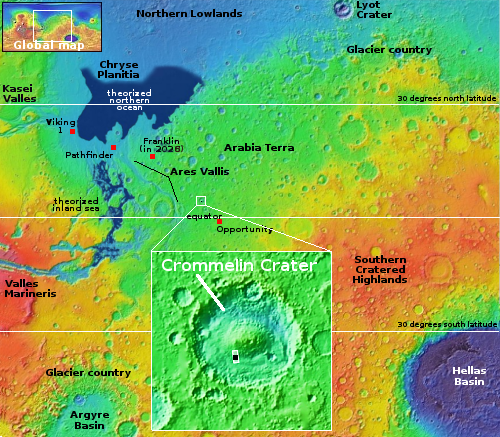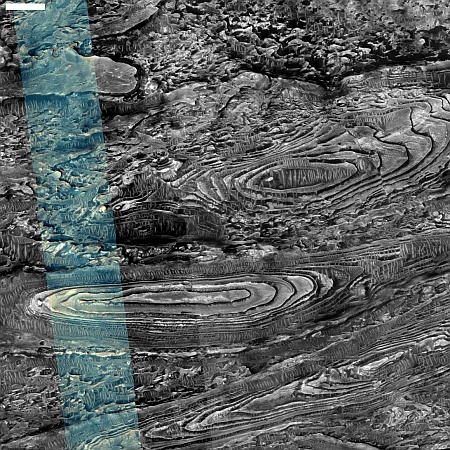Are these Martian terraced mesas or pits?
Cool image time! The picture to the right, cropped, reduced, and enhanced to post here, was taken on July 2, 2024 by the high resolution camera on Mars Reconnaissance Orbiter (MRO). I have purposely enhanced the contrast to bring out the strangely shaped and terraced features.
What I cannot figure out from any data available to me is whether these terraced features are mesas rising up, or pits descending down. The resolution in the global mosiac of Mars created both from MRO’s context camera and its elevation data is simply not good enough. It suggests these are pits, but the sunlight is coming from the west, which based on the shadows suggest these could be pits or mesas.
In fact, the dark lines that appear to distinguish the terraces might not be shadows at all, but simply darker material that contrasts with the lighter material on each side.

On the overview map to the right, the black dot inside 71-mile-wide Crommelin Crater marks the location. Previous research has suggested these terraced-appearing features, found in several nearby craters, might be springs where water was released from underground aquifer sometime in the past. That this crater is in the middle of the dry tropics of Mars, the past presence of springs is further evidence that Mars has undergone significant climate and geological changes over time.
As for whether these are pits or mesas, there is this from the abstract of this paper:
Elongated structures (furrows) and concentric strata pattern that we refer to as ridge-and-trough, were described inside to Crommelin crater. [MRO elevation data] revealed that these morphologies developed within a flat topography and are inconsistent with gravitative processes.
In other words, the scientists themselves are unsure whether they are mesas or pits, and in fact may be neither, the visual data having nothing to do with the topography. If you look close at the picture, the ripple dunes suggest this, as the dunes are found both at the center and edges of these features. Normally such dunes are found in the low spots, where the sand gets trapped. That these dunes are found almost randomly suggests the alternating bright and dark bands are intrinsic to the ground, and have nothing to do with any elevation changes at all.
That earlier research suggested the dark bands were basalt, laid down during periodic volcanic lava events.
On Christmas Eve 1968 three Americans became the first humans to visit another world. What they did to celebrate was unexpected and profound, and will be remembered throughout all human history. Genesis: the Story of Apollo 8, Robert Zimmerman's classic history of humanity's first journey to another world, tells that story, and it is now available as both an ebook and an audiobook, both with a foreword by Valerie Anders and a new introduction by Robert Zimmerman.
The print edition can be purchased at Amazon or from any other book seller. If you want an autographed copy the price is $60 for the hardback and $45 for the paperback, plus $8 shipping for each. Go here for purchasing details. The ebook is available everywhere for $5.99 (before discount) at amazon, or direct from my ebook publisher, ebookit. If you buy it from ebookit you don't support the big tech companies and the author gets a bigger cut much sooner.
The audiobook is also available at all these vendors, and is also free with a 30-day trial membership to Audible.
"Not simply about one mission, [Genesis] is also the history of America's quest for the moon... Zimmerman has done a masterful job of tying disparate events together into a solid account of one of America's greatest human triumphs."--San Antonio Express-News
Cool image time! The picture to the right, cropped, reduced, and enhanced to post here, was taken on July 2, 2024 by the high resolution camera on Mars Reconnaissance Orbiter (MRO). I have purposely enhanced the contrast to bring out the strangely shaped and terraced features.
What I cannot figure out from any data available to me is whether these terraced features are mesas rising up, or pits descending down. The resolution in the global mosiac of Mars created both from MRO’s context camera and its elevation data is simply not good enough. It suggests these are pits, but the sunlight is coming from the west, which based on the shadows suggest these could be pits or mesas.
In fact, the dark lines that appear to distinguish the terraces might not be shadows at all, but simply darker material that contrasts with the lighter material on each side.

On the overview map to the right, the black dot inside 71-mile-wide Crommelin Crater marks the location. Previous research has suggested these terraced-appearing features, found in several nearby craters, might be springs where water was released from underground aquifer sometime in the past. That this crater is in the middle of the dry tropics of Mars, the past presence of springs is further evidence that Mars has undergone significant climate and geological changes over time.
As for whether these are pits or mesas, there is this from the abstract of this paper:
Elongated structures (furrows) and concentric strata pattern that we refer to as ridge-and-trough, were described inside to Crommelin crater. [MRO elevation data] revealed that these morphologies developed within a flat topography and are inconsistent with gravitative processes.
In other words, the scientists themselves are unsure whether they are mesas or pits, and in fact may be neither, the visual data having nothing to do with the topography. If you look close at the picture, the ripple dunes suggest this, as the dunes are found both at the center and edges of these features. Normally such dunes are found in the low spots, where the sand gets trapped. That these dunes are found almost randomly suggests the alternating bright and dark bands are intrinsic to the ground, and have nothing to do with any elevation changes at all.
That earlier research suggested the dark bands were basalt, laid down during periodic volcanic lava events.
On Christmas Eve 1968 three Americans became the first humans to visit another world. What they did to celebrate was unexpected and profound, and will be remembered throughout all human history. Genesis: the Story of Apollo 8, Robert Zimmerman's classic history of humanity's first journey to another world, tells that story, and it is now available as both an ebook and an audiobook, both with a foreword by Valerie Anders and a new introduction by Robert Zimmerman.
The print edition can be purchased at Amazon or from any other book seller. If you want an autographed copy the price is $60 for the hardback and $45 for the paperback, plus $8 shipping for each. Go here for purchasing details. The ebook is available everywhere for $5.99 (before discount) at amazon, or direct from my ebook publisher, ebookit. If you buy it from ebookit you don't support the big tech companies and the author gets a bigger cut much sooner.
The audiobook is also available at all these vendors, and is also free with a 30-day trial membership to Audible.
"Not simply about one mission, [Genesis] is also the history of America's quest for the moon... Zimmerman has done a masterful job of tying disparate events together into a solid account of one of America's greatest human triumphs."--San Antonio Express-News



To my old worn out eyes they look like very low flat mesas. Another one of those spots that are waiting for “boots on the ground” confirmation. One of the coolest Cool Images in a while. Thanks.
Mars is weird!
Presumably, when they say “ridge-and-through” they mean “ridge-and-trough.”
Michael McNeil: I had intended on fixing their typo and forgot. Now corrected.